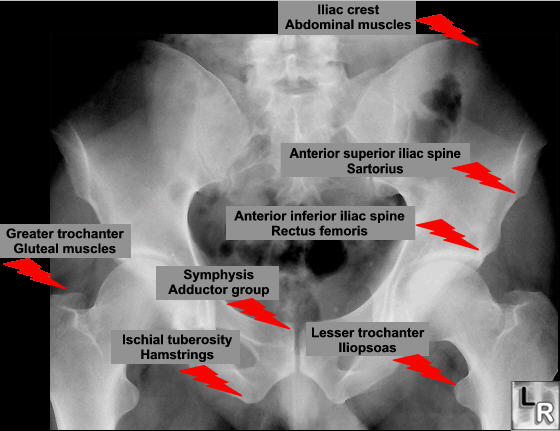|
|
Pelvic Avulsion Fractures
|
Avulsion Anterior
Superior
Iliac Spine (ASIS) |
Avulsion Anterior
Inferior
Iliac Spine (AIIS) |
|
|
|
Abdominal muscles
Uncommon
Log-distance runners |
Sartorius
Sprinters, hurdlers
Pain below iliac crest
|
Rectus femoris muscle
Less common than ASIS fractures
Kicking in soccer or football
|
Avulsion Ischial Tuberosity
|
Avulsion Greater Trochanter |
Avulsion Lesser Trochanter |
|
|
|
Hamstring
Most common avulsion
Sprinters, cheerleaders, dancers
Pain in buttock
|
Middle and least gluteal, internal obturator, gemellus, and piriform muscles
Sudden directional changes |
Iliopsoas
Rare
Very painful
Runners
|
General Considerations
- Avulsion fractures result when the fracture fragment is pulled from its parent bone by forceful contraction of a tendon or ligament
- Avulsion fractures are most common in younger individuals engaging in athletic endeavors
- In the pelvis, the newly formed secondary centers of ossification, the apophyses, are the most likely portions of the bone to avulse
- Since the apophyses tend to form at the time of puberty, most of these pelvic avulsions occur at the time of puberty
- In general, they are uncommon injuries, seen almost exclusively in adolescent athletes with a 2:1 male to female preponderance
- They occur most often in track events like hurdling and sprinting, or games like soccer or tennis
- Most common to avulse is the ischial tuberosity followed by anterior inferior iliac spine (AIIS) and the anterior superior iliac spine (ASIS) about equally
- Prompt diagnosis will prevent development of chronic pain
Clinical findings
- Acutely, the athlete experiences sudden, shooting pain referred to the involved tuberosity
- They may lose muscular function
- Swelling and local tenderness may occur
- The clinical findings of the fracture are similar to those of soft tissue injuries to the muscles, tendons and ligaments and so may be initially missed
- Most common site of a missed fracture is the ischial tuberosity
Imaging findings
- Since the apophyses occur in anatomically predictable locations, the findings are those of an avulsed bony fragment usually immediately adjacent to the parent bone
- Characteristic of these lesions is fracture healing with exuberant bony callus formation
- Can be confused with a bone tumor but must not be as an osteosarcoma and a healing fracture may appear similar pathologically
- Conventional radiography is the study of first choice
- If negative, magnetic resonance imaging may be helpful in demonstrating soft tissue injury, such as a tear of the tendon of the hamstring muscles

Avulsion Fractures Around the Pelvis and the Attachments of Muscles

Healing avulsion fracture of ischial tuberosity. There is exuberant callus formation around the site of an
avulsed ischial tuberosity in this 16 year-old young man who was a school hurdler. The location and
appearance are typical for this type of fracture and must not be confused for a bone tumor.
For a larger photo of the same image, click here
Imaging Features of Avulsion Injuries.
MA Stevens, GY El-Khoury, MH Kathol, EA Brandser and S Chow. May 1999, Radiographics, 19, 655-672.
|
|
|